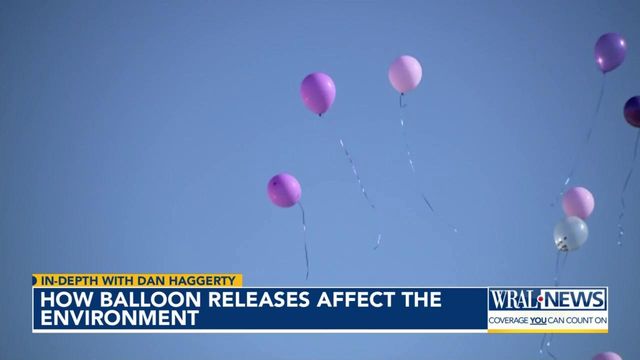Are balloon releases worth the environmental cost?
Family members and friends of people who die young often remember their loved ones with a balloon release.
After WRAL’s latest documentary “UnSafe: North Carolina kids dying from gun violence,” showcased a balloon memorial for an 8-year-old shot and killed, several people sent emails to the station about balloon releases.
“Balloon releases are an environmental nightmare,” a viewer named Holly wrote.
“It makes me cringe to think of the harm it causes the environment,” another viewer named Ann wrote.
“I learned about the negatives of balloon releases in elementary school,” a viewer named Jennifer wrote. “Time to educate a new generation.”
In 1986, the city of Cleveland inflated more than 1.5 million balloons, filling the size of a city block, and let them fly.
When the balloons started to fall, they caused crashes on the roads and shut down a local airport.
Since Cleveland is on the coast of Lake Erie, more than half of the balloons fell into the water when the wind shifted. It complicated the search for two missing boaters who disappeared before the launch.
Balloon releases are part of birthday parties, weddings, graduations, gender reveals and holidays among other things.
Balloons can fly a long way. In 2013, a boy from England did a school project where his class released 300 balloons with notes attached. One of those balloons was found by a girl named Millie in her backyard in southern Australia more than 10,000 miles away. For perspective, it's about 3,000 from the East Coast of the U.S. to the West Coast.
“We find them out in oceans where we’re studying whales or other marine fauna,” said Stanford University researcher Matthew Savoca. “It’s not totally uncommon to find balloons out in the open ocean.”
Litter is a huge problem in the ocean.
The Great Pacific Garbage Patch covers more than 600,000 square miles of floating garbage. It’s more than 12 times the size of North Carolina. Balloons stand out among the garbage, Savoca said.
“Not all debris is made equal, and balloons are among the most harmful debris items that we find in our oceans and aquatic environments,” Savoca said. “They’re more likely to cause harm, injury and death to wildlife than most other types of debris.”
A few months ago, a whale washed ashore in Emerald Isle, North Carolina. Scientists said the whale died after ingesting a plastic balloon. There are countless of other examples of balloons harming to wildlife.
There’s an entire Facebook page dedicated to finding balloons and the animals they kill in the middle of the desert.
North Carolina has no specific laws against balloon releases. However, several other states do.
In Florida, a bill calling for the ban of intentional balloon releases is heading to Gov. Ron DeSantis’ desk to become law.
Many people think sky lanterns – which are biodegradable – are a better alternative to balloon releases. However, it still takes decades for sky lanterns to break down. They’re also filled with fire.
In 2020, three women celebrating New Year’s in Germany lit lanterns that drifted into a zoo and started a fire that killed 30 animals, including apes.
Fires get started from sky lanterns, which is why several states have banned them. They are banned in North Carolina, according to the state fire code.
Other ideas to provide safe tributes include luminaries, blowing bubbles, lighting candles or anything that you can clean up afterwards.
Why do people still use balloons or sky lanterns? People who are mourning often don’t think about it.
Balloons are not among the top 10 most-littered plastic items in the U.S. Water bottles, plastic bags and takeout containers are a much bigger problem, especially because in Wake County, people are not allowed to recycle plastic food containers, plastic cups or plastic bags.
The city of Raleigh’s website reminds people that plastic bags get stuck in sorting machines.












